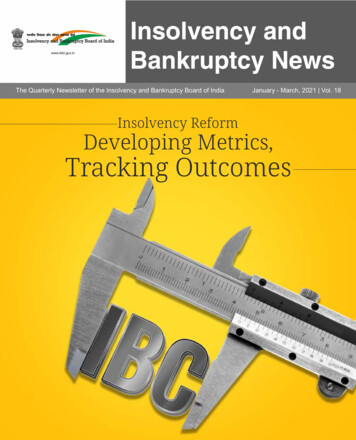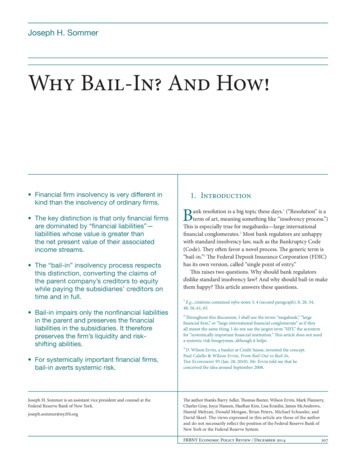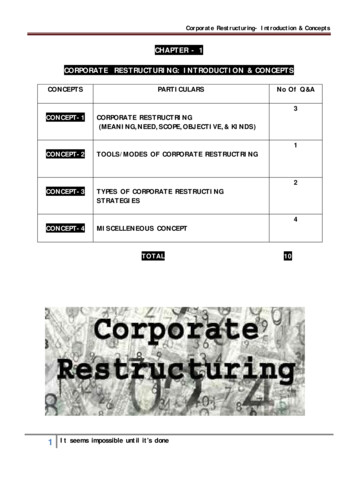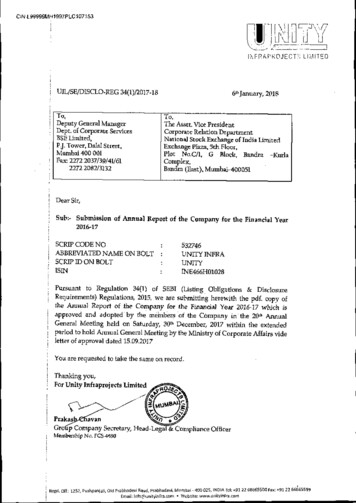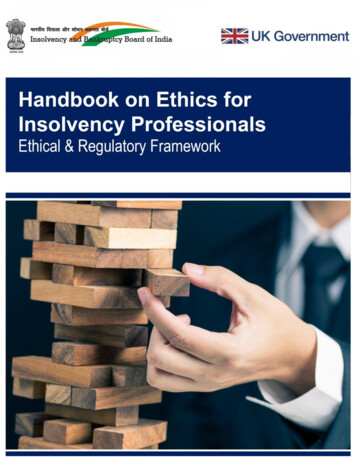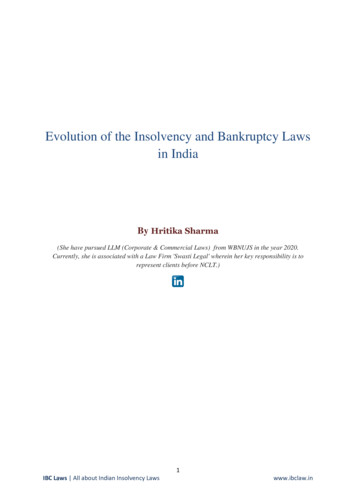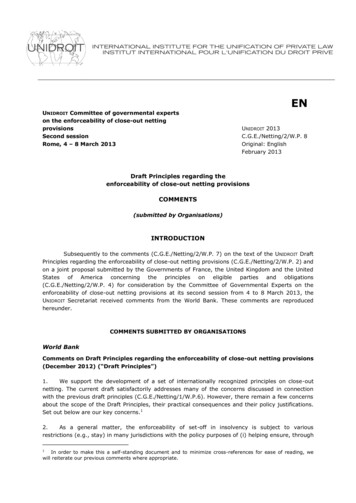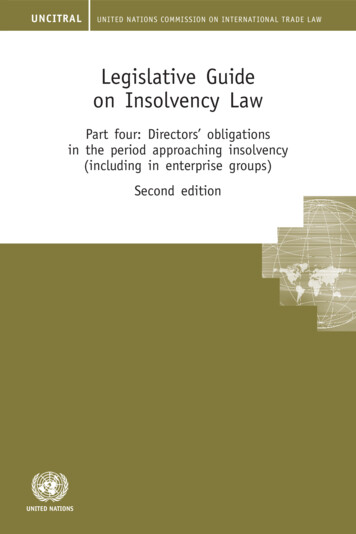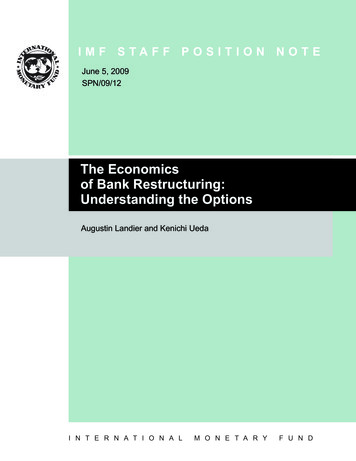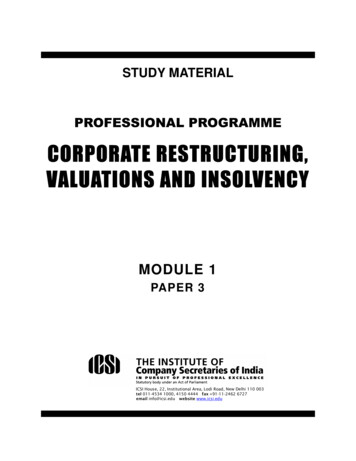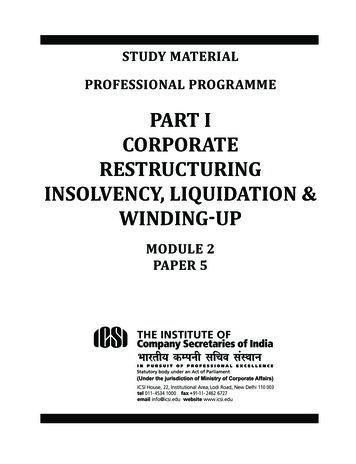
Transcription
STUDY MATERIALPROFESSIONAL PROGRAMMEPart ICorporateRestructuringInsolvency, Liquidation &Winding-upMODULE 2PAPER 5
THE INSTITUTE OF COMPANY SECRETARIES OF INDIATIMING OF HEADQUARTERSMonday to FridayOffice Timings – 9.00 A.M. to 5.30 P.M.Public Dealing TimingsWithout financial transactions – 9.30 A.M. to 5.00 P.M.With financial transactions – 9.30 A.M. to 4.00 si.eduE-mailinfo@icsi.eduLaser Typesetting by Satyabrata Mohapatra, Noida andPrinted at HT Media Ltd, Greater Noidaii
Professional ProgrammeCorporate Restructuring, InsolvencyLiquidation & Winding-upCorporate restructuring is a collective term for a variety of different business transactions. Mergers, amalgamations,acquisitions, compromises, arrangement or reconstruction are all different forms of corporate restructuringexercises in the corporate world. Corporate restructuring might result in changes like change in share capital orcapital structure, change of shareholders, change of control, change of business, change of operating entities, etc.Corporate restructuring serves different purposes for different companies at different points of time. It may take upvarious forms. The purpose of each of these restructuring activities is different but each one of them is targeted torebuild or rearrange the corporate structure.A company may grow his business either by internal expansion or by external expansion. In the case of internalexpansion, a company grows gradually overtime in the normal course of the business, through acquisition ofnew assets, replacement of the technologically obsolete equipments and the establishment of new lines ofproducts. But in external expansion, a firm acquires a running business and grows overnight through corporaterestructuring.Corporate Restructuring is a non-recurring exercise for an organisation but it has a lasting impact on the business andother concerned agencies due to its numerous considerations and immense advantages viz., improved performance,better corporate governance etc. The regulatory provisions and the multitude of judicial and unresolved issuesenunciate that the professionals dealing with restructuring should possess unequivocal and explicit knowledge ofthe objective approach and perspective of the subject.Companies use restructuring as a business strategy to ensure their long-term viability. Shareholders or creditorsmight force a restructuring if they observe the company’s current business strategies as insufficient to preventa loss on their investments. The nature of these threats can vary, but common catalysts for restructuring involvea loss of market share, the reduction of profit margins or decline in the power of their brand. Other motivatorsof restructuring include the inability to retain talented professionals and major changes to the marketplace thatdirectly impact the corporation’s business model.Company Secretaryship being a professional course, the examination standards are set very high, with emphasis onknowledge of concepts, applications, procedures and case laws, for which sole reliance on the contents of this studymaterial may not be enough. Besides, as per the Company Secretaries Regulations, 1982, students are expectedto be conversant with the amendments to the laws made upto six months preceding the date of examination. Thematerial may, therefore, be regarded as the basic material and must be read along with the original Bare Acts, Rules,Regulations, Case Law, Student Company Secretary e-bulletin and Chartered Secretary published by the Institute aswell as recommended readings.This Study Material is based on the provisions which are notified under Companies Act, 2013 and Insolvency andBankruptcy Code, 2016. The amendments made up to August, 2021 have been incorporated in this study material.However, it may so happen that some developments might have taken place during the printing of the study materialand its supply to the students. The students are therefore, advised to refer to the website of the Institute for updationof the study material.Although care has been taken in publishing this study material, yet the possibility of errors, omissions and/ordiscrepancies cannot be ruled out. This publication is released with an understanding that the Institute shall not beresponsible for any errors, omissions and/or discrepancies or any action taken in that behalf.iii
Should there be any discrepancy, error or omission noted in the study material, the Institute shall be obliged if thesame are brought to its notice for issue of corrigendum in the Student Company Secretary e-bulletin. In the event ofany doubt, students may write to the Directorate of Professional Development, Perspective Planning and Studies inthe Institute for clarification at academics@icsi.edu.Relevance of the Subject for the ProfessionCorporate restructuring as a business re-organisation tool holds lot of scope and potential as an area of practice.Corporate restructuring is been growing day by day and becoming a useful tool to overcome difficult times for thetroubled businesses or the business who aspire to grow at a faster pace using the ample growth opportunitiesavailable in the global market. But it being a complex and technical area require lot of know-how of legal, financial,taxation, management and other related areas. These complexities require involvement of professionals to seamlesslyconduct the corporate restructuring exercise.The subject is inherently technical and is subjected to constant refinement through new legislations, rules andregulations made thereunder, court decisions on specific legal issues and corporate business dynamics. In Indianscenario various regulatory approvals and compliances are required to complete a scheme of arrangement, therefore,it becomes necessary for professionals to constantly update with the various legislative changes made as well asjudicial pronouncements rendered from time to time by referring to the law/professional journals. This study aimsto provide an in-depth understanding of all aspects and intricacies of law and practical issues affecting and arisingout of Corporate Restructuring, Valuation as well as Insolvency.The role of professionals becomes more relevant in the wake of cross-border mergers and takeovers since legaland taxation requirements vary from one nation to another. Corporate restructuring involves decision on varioustechnical and legal aspects such as valuation of organizations involved in restructuring process, swap ratio of sharesif any, legal and procedural aspects with regulators such as Registrar of Companies, Tribunal, etc., optimum taxbenefits after merger, human and cultural integration, stamp duty cost involved, etc. All these activities requiresprofessionals including business experts, Company Secretaries, Chartered Accountants, HR professionals, etc., whohave a role to play in various stages of restructuring process.Since corporate restructuring activities in India are primarily governed by the Companies Act, 2013, SEBI,FEMA and other allied laws which are expert areas for a Company secretary, it is an emerging area of practicefor Company Secretaries to help companies in carrying out restructuring practices. Company Secretaries havein-depth knowledge of provisions of Companies Act, rules and regulations, NCLT rules, valuation and alliedareas affecting the compromise and arrangement and other regulatory and compliance requirements as perprevailing law.It is an area of specialization where the stakeholders expect the Company Secretaries to be experts. The study willenable students/members to acquire competence and professional skills to develop themselves into ‘CorporateManagers’ / ‘Corporate Advisors’.Hybrid Subject – Corporate Restructuring, Insolvency, Liquidation & Winding-Up is a hybrid subject whichrequire expertise and integrated application of several core areas such as Company Law, Securities Laws,Insolvency Law, FEMA, etc. and ancillary areas such as Accounts, Finance, Taxation, Business and FinancialManagement, etc.Broad OrientationExpert Knowledge - comprehending, integrating and advising to resolve complex issues/problems, and decisionmaking.iv
Guidance on how to study the subjectCorporate Restructuring, Insolvency, Liquidation & Winding-Up is a technical subject which require in-depthknowledge of both law and procedures. Students may follow these steps to study the subject:1.Focus on understanding concepts and principles;3.Students should read the relevant sections of the bare acts for basic understanding of the underlying law.2.Students should develop art of reading, interpreting and understanding the law.4.To study practical problems, judicial pronouncements, case studies, compliance requirements, etc. forunderstanding practical aspects and intent of law.6.To study Institutes publications such as Chartered Secretary, Student Company Secretary e-bulletin for recentupdates.5.7.To study Act, Rules, Regulations, Notifications, Clarifications, Removal of Difficulties Orders, Guidelines,circulars, forms, etc.To visit websites of regulatory bodies for the recent amendments/notifications/orders, etc.v
LEGAL FRAMEWORKMERGER & ACQUISITIONSApplicable tolistedcompaniesApplicable toall companiesSEBI (LODR)Regulations,2015CompaniesAct, 2013CompetitionAct, 2002RBI andFEMARegulationsIncome-taxAct, 1961IndianStamp Act,1899IndustrySpeci icLawsAccountingStandardsviOther SEBIRegulations
Professional ProgrammeModule 2Paper 5Corporate Restructuring, InsolvencyLiquidation & Winding-Up(Max Marks 100)ObjectivePart I: To provide expert knowledge of legal, procedural and practical aspects of Corporate Restructuring, Merger&Acquisitions, Insolvency, Liquidation & Winding-up.Part II: To acquire knowledge of the legal, procedural and practical aspects of Insolvency and its resolution.Detailed ContentsPART I- Corporate Restructuring (50Marks)1.2.3.4.5.6.7.8.Types of Corporate Restructuring: Key definitions, Compromises, Arrangements, Mergers & Amalgamations;Demergers & Slump Sale, Business Sale; Joint Venture, Strategic n of Company/ Business: Acquisition of Company; Takeover of Listed Companies (i) LegalFramework (ii) Process & Compliances; Cross Borders Takeovers – Procedure.Planning & Strategy: Case Studies pertaining to Merger, Amalgamation, Restructuring; Funding for M&A,Studies of Judicial pronouncements; Planning relating to acquisitions & takeovers; Protection of minorityinterest; Succession Planning; Managing Family Holdings through Trust.Process of M&A transactions: Key Concepts of M&A; Law & Procedure; M&A Due Diligence; M&A Valuation;M&A Structure finalization; Post transaction integration.Documentation–Merger & Amalgamation: Drafting of Scheme; Drafting of Notice and ExplanatoryStatement; Drafting of application & Petition.Valuation of Business and Assets for Corporate Restructuring: Type of Valuations; Valuation Principles &Techniques for Merger, Amalgamation, Slump Sale, Demerger; Principles & Techniques of Reporting; Relativevaluation and Swap ratio.Accounting in Corporate Restructuring: Concept and Accounting Treatment: Methods of Accounting forAmalgamations - AS-14/ IndAS 103; Treatment of Reserves, Goodwill; Pre-Acquisition & Post- AcquisitionProfit; Accounting in Books of Transferor and Transferee; Merger and De-Merger; Acquisition of Business andInternal Reconstruction.Taxation & Stamp Duty aspects of Corporate Restructuring: Capital Gain; Set-off and carry forward undersection 2(14) of Income Tax Act; Deemed Dividend; Payment of Stamp Duty on scheme, payment of stamp dutyon movable and immovable properties.vii
9.10.11.12.13.Competition Act: Regulation of combinations under the competition Act, Kinds of combinations, Exemptedcombinations, Concept of relevant market and its importance, Determination of combinations and anyappreciable adverse effect, Role of CCI.Regulatory approvals of scheme: From CCI, Income Tax, Stock Exchange, SEBI, RBI, RD, ROC, OL and SectorRegulators such as IRDA, TRAI, etc.Appearance before NCLT / NCLAT.Fast Track Mergers: Small companies, Holding and wholly owned companiesCross Border MergersCase Laws/Case Studies/Practical Aspectsviii
Lesson Wise SummaryCorporate Restructuring, InsolvencyLiquidation & Winding-UpPART I- CORPORATE RESTRUCTURINGLesson 1: Types of Corporate RestructuringCorporate restructuring is an inorganic growth strategy of redesigning one or more aspects of a business.Restructuring typically occurs as a result of business analysis that shows a need for greater efficiency to completetasks. Sometimes a particular segment of the business will start to fail, and the company will need to reallocateresources in order to support it. Sometimes a business may have expanded too much, and needs to refocus on itscore abilities. At other times a business may need to restructure its financial position in order to continue makingprofits. Often, restructuring plans are necessary simply to meet the constantly changing demands of technologythat competitors are embracing, survive a currently adverse economic weather, or poise the corporation to movein an entirely new trend. Some of common ways to carry our Restructuring process are mergers/amalgamations,acquisitions/takeovers, divestitures/demergers, slump sale, business sale; joint venture, strategic alliance, financialrestructuring (buy-back, alteration & reduction). This lesson covers the concept of corporate restructuring, itsimportance, historical background, available tools and emerging trends in restructuring strategies, etc.Lesson 2: Acquisition of Company/ BusinessAn acquisition is a situation whereby one company purchases most or all of another company’s shares in order totake control. An acquisition occurs when a buying company obtains more than 50% ownership in a target company.Corporate Sector is an attractive medium for carrying on business as it offers a lot of benefits. Raising money frompublic has its own positive features and it helps setting up big projects. When promoters of a company desire toexpand, they take a quick view of the industrial and business map. If they find there are opportunities, they willalways yearn for capitalizing such opportunities. Compared to the efforts required, cost and time needed in settingup a new business, it would make sense to them to look at the possibilities of acquiring an existing entity. SEBI(Substantial Acquisition of Shares and Takeovers) Regulations, 2011 prescribes disclosure requirements, open offerthresholds and other procedural aspects to takeover. This lesson covers the meaning, concept, objectives of takeover,procedural requirements as to takeover of listed/ unlisted companies, takeover defenses etc.Lesson 3: Planning & StrategyIn order to make a merger work, it is pertinent to have a sound strategic planning so that maximum benefit is takenout from the merger. The company doing the acquisition must evaluate the performance, market position, cashflows, future opportunities, technology, regulatory issues of the target company to fix the right price for the deal.It is important to identify synergy between the two companies. Most prominently, the strategy must lay out thebusiness drivers of the merger and factor in all the risks associated with the merger. Once the basic strategy is inplace, then the acquiring company must look at the finances. Financing the deal can be done from myriad sourceslike cash, own accruals, debt, public and private equities, minority investments, etc. One must evaluate the cost ofthe fund depending on the needs and the amount of returns that the deal can fetch in the medium to long-run. Thislesson covers the planning and strategy, purchase and protection of minority interests, succession planning and thefunding process for mergers and acquisitions.ix
Lesson 4: Process of Merger & Acquisition transactionsStrategic decision of merger/amalgamation by the transferor/transferee company require compliance with anumber of regulations viz., the Companies Act, 2013, National Company Law Tribunal Rules, 2016, Income TaxAct, 1961, The Indian Stamp Act, 1899, The Competition Act, 2002 etc. Due Diligence and Valuation are twomost important aspects. Mergers and amalgamations involves conducting of various meeting including board/general meetings, obtaining of various approvals from regulators like Stock Exchanges, National Company LawTribunal (NCLT) , Ministry of Corporate Affairs (ROC/RD), drafting of documents such as preparation of scheme,notices/explanatory statements, filing of various documents including e- forms with ROC, filing of schemeof amalgamation with NCLT, etc. This lesson covers the regulatory framework, interpretations of provisionsin the Companies Act relating to merger/amalgamation, different approvals, steps involved, integration notonly of the financials, accounting and software but also of the human and cultural integration and judicialpronouncements, etc.Lesson 5: Documentation – Merger & AmalgamationMergers and acquisitions require a lot of legal documentation, hence drafting skills of an expert level is required.Besides that, a lot of coordination is required with statutory authorities and the same requires a lot of planningand patience at the Company Secretary’s end. It’s a wholesome procedure which demands not only internalcoordination with team members, but also good liasoning skills with external parties. Proper understandingof documents required and skill to prepare them is an essential element for achieving desired results. Everyprofessional involved in merger and amalgamation documentation should possess necessary expertise to draftthe scheme along with attachments required in order to streamline the process of submission of petition and itsapproval. Company Secretary being an expert in drafting has an edge over others, to grab the ample opportunitiesavailable in this area of work. The study lesson covers the documentation involved, points to be factored whiledrafting such documents and general provisions under the Companies Act, 2013 and NCLT Rules with respect tomergers and amalgamations.Lesson 6: Valuation of Business and Assets for Corporate RestructuringValuation is one of the most important factor in determining the accurate and realistic value of companies inmergers and acquisitions. Circumstances requiring valuation are discussed. Valuation provides a useful base toestablish a price for the property. The main objective in carrying out a valuation is to conclude a transaction in areasonable manner without any room for any doubt or controversy about the value obtained by any party to thetransaction. There are various methodologies for valuing a business, all having different relevance depending onthe purpose of valuation. These methodologies include asset based approach, earnings based approach and marketbased approach. Besides regulatory aspects also impact valuation. For example there are regulatory prescriptionsfor valuation of shares under SEBI (SAST) Regulations, 2011, SEBI (ICDR) Regulations, 2018, SEBI (Share BasedEmployee Benefits) Regulations, 2014, FEMA/Consolidated FDI Policy, Income Tax Act, 1961, etc. This lesson coversthe meaning, purpose and methods of valuation, the regulatory aspects of valuation, etc.Lesson 7: Accounting in Corporate Restructuring – Concept and Accounting TreatmentThere are many accounting issues involved in the merger and acquisition. The main issues like accounting byacquirer, valuation of goodwill and reserve of the Target Company and accounting method. Accounting standard(AS-14) prescribes for accounting and disclosure requirements of merger and acquisition. According to AS14amalgamation may be either in the nature of merger or in the nature of purchase. IND-AS 103 deals with meaning ofbusiness, business combination. According to IND-AS 103, business combination is accounted applying acquisitionmethod. This lesson covers various developments happening in M&A accounting, concepts of demerger and internalreconstruction and also major difference between IND-AS 103 and IFRS 103.x
Lesson 8: Taxation & Stamp Duty aspects of Corporate RestructuringIn any corporate restructuring financial, taxation and stamp duty aspects play a pivotal role in accepting or rejectinga deal. Often a restructuring though operationally and technically viable may fail due to taxation and other issues.Taxation and stamp duty aspects will have regulatory scrutiny also. Capital Gain; Set-off and carry forward; DeemedDividend; Payment of Stamp Duty on scheme, payment of stamp duty on movable and immovable properties areimportant considerations. Financial aspects of merger denote financial benefits. Stamp duty and taxation aspectsare closely linked to the financial aspects. Similarly, the incidence of stamp duty is an important consideration in theplanning of any merger. In fact, in some cases, the whole form in which the merger is sought to take place is selectedtaking into account the savings in stamp duty. Taxation aspects of merger includes aspects such as carry forward oflosses after merger. This lesson covers the regulatory aspects and court decisions as to the stamp duty aspects ofmergers, tax advantage on mergers, etc.Lesson 9: Competition ActCompetition law being an economic legislation regulates merger (called combinations) deals with threshold limits(domestic/cross border), notice to Competition Commission of India etc. The lesson covers Regulation of combinationsunder the competition Act, Kinds of combinations, Exempted combinations, Concept of relevant market and itsimportance, determination of combinations and any appreciable adverse effect, Role of CCI. It is of utmost importancefor Company Secretaries to have thorough knowledge of the precedents, orders and decisions made by the overseascontemporary authorities as well as the leading decisions of the Commission. It is worth highlighting that the filingprocess is not easy; rather, parties need to be well-prepared and carefully assess all possible market definitions. Roleof professionals is important in advising the Board of directors about competition aspects of proposed merger andacquisition, filing before the Commission and representing the case where the Commission deems it necessary to givean opportunity of being heard to the parties to the combination before deciding the case. This lesson covers basicsabout combinations, their regulation and thresholds, etc. as specified in the Competition Act, 2002.Lesson 10: Regulatory approvals of schemeCorporate restructuring is an inevitable event in life of a corporate in dynamic and fast changing environment.Regulatory regime for mergers and acquisitions in India require approvals from CCI, Income Tax, Stock Exchange,SEBI, RBI, RD, ROC, OL and Sector Regulators such as IRDA, TRAI, etc. The merger and takeover involves variousissues and compliance not even of the Companies Act, 2013, but from the other Regulators also depending uponthe nature of business of the company and sector under which it is operating. From this point of view it becomesnecessary for a student of professional programme to know various procedural aspects, regulatory approvalsrequired to complete these events. It is to be noted in corporate world such professionals having an expertise inthese procedural aspects are in great demand. This lesson covers the various approval required in case of merger/amalgamation, acquisition/ takeovers, etc.Lesson 11: Appearance before NCLT / NCLATBasic framework before NCLT governed by the Companies Act, 2013, National Company Law Tribunal Rules,2016, National Company Law Appellate Tribunal Rules, 2016, Companies (Compromise, Arrangements andAmalgamations) Rules, 2016is discussed in this lesson. Constitution of NCLT provides various opportunities forprofessionals to appear and represent before the Tribunal in case of mergers / amalgamation / demerger / reductionof share capital, winding-up proceeding, oppression and mismanagement, conversion of a company from public toprivate, etc. Practicing Company Secretaries render services in preparing schemes, appearing before NCLT/NCLATfor approval of schemes and post-merger formalities. The comprehensive reading of corporate laws and ampleamount of relevant training empowers the Company Secretaries to have edge over other professionals to deal withprocedural and/ or practical oriented matters/ issues pertaining to Companiesxi
Act. This lesson covers the basic requirements and skills, Scope for PCS under NCLT, Dress Code, Etiquettes, Courtcraft to appear and represent before NCLT/NCLAT.Lesson 12: Fast Track MergersIntroduction, applicability and procedure for Fast track mergers under Section 233 of the Companies Act, 2013,Rule 25 of Companies (Compromises, Arrangements and Amalgamations) Rules, 2016 and related concepts of smallcompany are covered in this lesson. Company Secretary plays an important role in the restructuring process andoften advises his/her clients as to the procedure to be adopted, forms to be filed, etc. Hence, it is important for themto learn the basic concepts of what is a fast track merger, to whom does it apply, how can it be invoked, what arethe requisite steps and which forms are required to be filed.This lesson covers about concept of fast track merger,procedure involved in fast track merger, etc.Lesson 13: Cross Border MergersConceptual understanding of cross border mergers including the need for the introduction of outbound mergers, thelegal provisions to be invoked and used, valuation issues pertaining to Cross Border Mergers, the tax/ accountingimplications, how to assess if a merger would be beneficial or not and the post-merger evaluation of a firm. Section234 of the Companies Act, 2013 and Rule 25A of the Companies (Compromises, Arrangements and Amalgamation)Rules, 2016 which provide for the basic legal framework involved in cross border mergers is discussed. This lessoncovers concept of cross border mergers, legal framework surrounding cross border mergers, concepts of inboundand outbound mergers, risks and benefits associated with a cross border merger, etc.xii
List of Recommended Booksand Other ReferencesModule 2 Paper 5Corporate RestructuringInsolvency, Liquidation & Winding-UpRecommended Readings and References1.Relevant Bare Acts3.M.C. Bhandari2.4.5.6.7.8.9.10.A. RamaiyaGuide to Companies Act, Lexis Nexis Butterworths, Wadhwa, NagpurTaxmannMaster Guide to Companies Act 2013 & Company RulesS K KatariaSridharan and PradhanICSIK.R. SampathS. RamanujamRayImportant (e)(f)The Companies Act, 2013 with Rules and Ready Referencer by BloomsburyPublicationGuide to Takeovers and Mergers by Wadhwa & Co.Handbook on Mergers Amalgamations and Takeovers.Mergers/Amalgamations, Takeovers, Joint Ventures, LLPs and CorporateRestructure, Snow White PublicationsMergers et al, Lexis Nexis Butterworths Wadhwa NagpurMergers and Acquisitions Strategy, Valuation and Integration, n(h)Guide to Company Law Procedures, Lexis Nexis Butterworths Wadhwa Nagpurwww.drt.gov.inxiii
Arrangement of Study LessonsModule 2 Paper 5Corporate RestructuringInsolvency, Liquidation & Winding-UpPart I – Corporate RestructuringSo.Lesson Tittle1.Types of Corporate Restructuring3.Planning & Strategy2.4.5.6.7.8.9.10.11.12.13.Acquisition of Company/ BusinessProcess of M&A transactionsDocumentation–Merger & AmalgamationValuation of Business and Assets for Corporate RestructuringAccounting in Corporate Restructuring—Concept and Accounting TreatmentTaxation & Stamp Duty aspects of Corporate RestructuringCompetition ActRegulatory approvals of schemeAppearance before NCLT / NCLATFast Track MergersCross Border Mergersxiv
ContentsPART I- CORPORATE RESTRUCTURINGLesson 1Types of Corporate RestructuringIntroduction2Historical Background2Types of Restructuring4Need and Scope2Legal Framework of Corporate RestructuringMost Commonly Applied Tools of Corporate RestructuringMergers/Acquisitions and AmalgamationReasons For Mergers & Acquisitions4666M&A Include a Number of Different Transactions8Example-Mergers and Acquisitions In India12Comparison Between Spin-off and Split-off1613DemergerSlump Sale16Business Sale/Divestiture17Joint Venture17Strategic Alliance18Reverse Merger18Financial Restructuring19Alteration of Share Capital20Reduction of Share Capital21Modes of Reduction of CapitalReduction of Capital and Scheme of Compromise and ArrangementBuy-BackBuy-Back Procedure For Private & Unlisted Public CompaniesIncome Tax AspectsBuy-Back Procedure For Listed Securities212424273030xv
Methods of Buy-Back32Public Announcement and Filing of offer Documents32Additional Disclosures32Escrow Account33Payment To The Security Holders34Extinguishing of Bought-Back Securities34Odd-Lot Buy-Back35Buy-Back From Open Market35Buy-Back Through The Stock ExchangeBuy–Back of Physical Shares Or Other Specified SecuritiesEscrow Account For Open Market Buy-Back Through Stock ExchangeExtinguishment of CertificatesBuy-Back Through Book-Building36363737Obligations of The Company38Obligations of The Merchant Banker39Lesson Round UpTest Yourself3539Lesson 2Acquisition of Company/Business41Meaning of Takeover44Kinds of Takeover44Objects of Takeover44Development of Takeover Regulations45Legal Aspects of Takeover46Takeover of Unlisted Companies46Check-List49Takeover of Listed Companies50Definitions50Trigger Points Under Takeover Regulations5252Open offer ThresholdsDelisting and The Takeover Regulations54xvi
Procedure For Making An Open offer55Public Announcement56Manager To The Open offer5556Timing of The Public AnnouncementDetailed Public Statement56offer Price56Letter of offer57Escrow Account5858Release of A
Corporate restructuring is been growing day by day and becoming a useful tool to overcome difficult times for the troubled businesses or the business who aspire to grow at a faster pace using the ample growth opportunities available in the global market. But it being a complex and technical area require lot of know-how of legal, financial,
